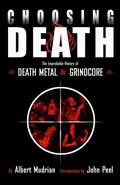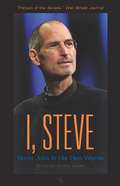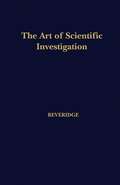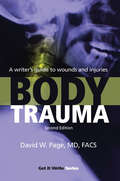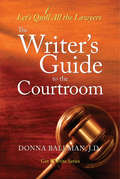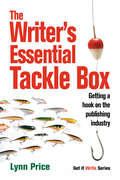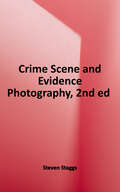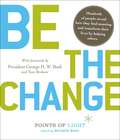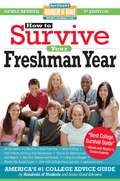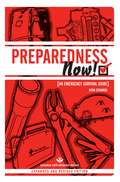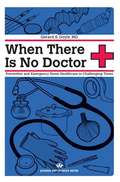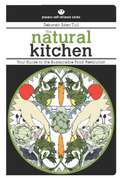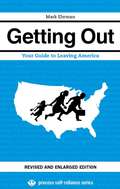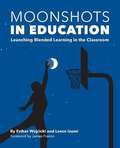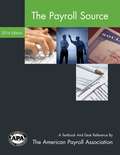- Table View
- List View
Choosing Death
by Albert MudrianThis exciting history, featuring an introduction by famed DJ John Peel, tells the two-decade-long history of grindcore and death metal through the eyes and ringing ears of the artists, producers, and label owners who propelled them.
I, Steve: Steve Jobs in His Own Words
by George BeahmThe quotes in "I, Steve" encapsulate everything I learned while I was at Apple: Paying attention to little details (because they matter). Relentless simplification. Knowing what to say 'no' to. These principles can apply to many aspects of business and reading them in Steve's words are an excellent reminder that we don't have to settle for mediocrity. This is not a biography, nor is it an exploitation of the man's death, as this book has been scheduled for publication for many months now. This book is an essential tool for how to think about the problems you wrestle with at work. Bring a copy to your office. Start off every meeting reading a random quote. See what happens.
Professional Meeting Management: A Guide To Meetings, Conventions And Events
by Professional Convention Management Association StaffThe sixth edition of Professional Meeting Management is the newest edition of the longtime standard reference and textbook for the meetings industry and meetings education. This is the first student and meeting professionals textbook aligned with the new Certified Meeting Professional (CMP) International Standards, which will be used by the Convention Industry Council as a reference book for item writing for the CMP Certification Examination. It includes the most up-to-date information on current trends, strategic planning for meetings, budgeting and funding, marketing and promotion, technology, running and closing the meeting, and industry developments on the horizon.
The Art of Scientific Investigation
by William I.B. BeveridgeIn The Art of Scientific Investigation, originally published in 1950, W.I.B. Beveridge explores the development of the intuitive side in scientists. The author's object is to show how the minds of humans can best be harnessed to the processes of scientific discovery. This book therefore centers on the "human factor"; the individual scientist. The book reveals the basic principles and mental techniques that are common to most types of investigation. Professor Beveridge discusses great discoveries and quotes the experiences of numerous scientists.
Body Trauma
by David W. PageBody Trauma explains what happens to body organs and bones maimed by accident or intent and the small window of opportunity for emergency treatment. Research what happens in a hospital operating room and the personnel who initiate treatment. Use these facts to bring added realism to your stories and novels.
The Writer's Guide to the Courtroom
by Donna BallmanOne-stop shopping for researching the complexities of all aspects of civil law. Whether one writes mysteries, romance, mainstream, or nonfiction, if the facts are wrong, the book is ruined. Adding some element of the law is also a valuable asset for adding further dimension or a plot twist to a story.
The Writer's Essential Tackle Box
by Lynn PriceThe Writer's Essential Tackle Box offers an insider's view that informs and educates writers to key occupations that comprise the publishing industry--how they work, why they work, and pitfalls to avoid. A must-read for the new author seeking guidance through every aspect of the murky waters of publishing.
Women of the Underground: Music
by Zora Von BurdenIn a series of 20 candid interviews with radical women musicians and performance artists, author Zora von Burden probes the depths of how and why they broke through society's limitations to create works of outstanding measure.
Stylish Weddings for Less: How to Plan Your Dream Wedding on a Budget
by Catherine SabinoSTYLISH WEDDINGS FOR LESS is a step-by-step timeline, with real life examples, resources and practical tips, will help you plan a beautiful but budget friendly wedding, from the dress to the honeymoon.
Crime Scene and Evidence Photography
by Steven StaggsThis book is designed for those responsible for photography at the crime scene and in the laboratory. It may be used by law enforcement officers, investigators, crime scene technicians, and forensic scientists. It contains instructions for photographing a variety of crime scenes and various types of evidence. It is a valuable reference tool when combined with training and experience. Crime Scene and Evidence Photography is also a helpful resource for students and others interested in entering into the field of crime scene investigation.
Exposed: The Toxic Chemistry of Everyday Products and What's at Stake for American Power
by Mark SchapiroThe United States was once the pioneer of new approaches to environmental protection. In the 1970s and 1980s an American mix of scientific rigor and legal muscle gave birth to a body of environmental regulations and laws that was seen as a model around the world. But no more; leadership has switched. The European Union is asserting new priorities that are far more protective of citizens' health and the environment than those in the United States and they have the economic muscle to back them up.
Energy: 100 Energy-saving Tips for the Home
by Jon Clift Amanda Cuthbert100 energy saving tips for everything in your home or business. Includes suggestions on heating and cooling, lighting, cooking, appliances and much more. Also provides an overview on renewable energy options.
Be the Change!
by Tom Brokaw George H. Bush David Hume Kennerly Michelle NunnBe the Change celebrates the personal transformations of men and women who, by working to change the world, changed themselves. Featuring interviews with over 1,000 volunteers, from everyday people to business and community leaders to celebrities, the book combines hands-on advice on ways to get involved with enlightening real-life stories from those who did. Inspirational yet practical, it's the perfect companion for readers who want to stop daydreaming about a more fulfilling life and a better world and take action to do so.Includes forewords by President George H. W. Bush and Tom Brokaw
How to Survive Your Freshman Year
by Frances Northcutt Yadin Kaufmann Ed.D. Scott Silverman Mark W. BernsteinHow to Survive Your Freshman Year offers incoming college freshmen the experience, advice, and wisdom of their peers: hundreds of other students who have survived their first year of college and have something interesting to say about it. Based on interviews with hundreds of college students at every type of higher-learning institution across the country, this book has insights on every aspect of college life, including, what to take to the dorm, living with roommates, Facebook and other social networks, extracurricular activities, choosing classes, studying, going abroad, finances, food, the social scene, doing laundry, staying in touch with friends and family, and much more. Highly readable, much of the book consists of short snippets with some interesting insight and advice from the college students interviewed. The book also includes expert input from college advisors and officers.
Where to Seat Aunt Edna?
by Besha RodellWhere to Seat Aunt Edna lets those who've already made the mistakes and endured the big day disasters - 634 of them - explain the "we do's" and "we don'ts" involved in pulling off a dream wedding. From that fateful announcement of intentions, fixing the guest list, and choosing the bridesmaids' dresses, to writing the vows, figuring out those mind-numbing seating arrangements, and testing out the band to avoid any karaoke-ish embarrassments, there's not a wedding dilemma that hasn't been encountered, retold, and solved somewhere in this ideal engagement gift.
How to Survive a Move
by Jamie Allen Kazz RegelmanIf you are one of the forty million Americans who will move this year, you know the task can seem overwhelming. Now, there's help. How to Survive A Move offers hundreds of helpful and entertaining stories on moving from the real "pros"- everyday people who have moved (many of them over a dozen times!) and survived to tell their stories.Unlike other moving books that give the opinion of one or two experts, How to Survive a Move includes words of wisdom from hundreds of people - both singles and families, nationwide - who have "been there, done that." Millions of people have survived moving, and so can you!
PREPAREDNESS NOW!
by Aton EdwardsIn uncertain times, a solid preparedness plan is essential for every individual and family. PREPAREDNESS NOW! navigates the new realities of twenty-first century living: extreme weather, economic instability, terror attacks, and more.Packed with checklists, resources, and step-by-step instructions, PREPAREDNESS NOW! details everything needed for office, car, and home preparedness. This newly expanded and revised edition includes an extended chapter on food and water storage and urban gardening, techniques in personal defense, and the latest and best preparedness products on the market. This book encourages basic lifestyle changes that lead to a more self-sufficient and satisfying existence, regardless of circumstance.PREPAREDNESS NOW! is written by one of the most experienced preparedness experts in the field. Aton Edwards is executive director of the International Preparedness Network (IPN) and has worked with the Red Cross, NYPD, Center for Disease Control, and thousands of people domestically and overseas.This manual delivers practical advice on: Building your emergency kits for home, car, and office Water quality control and storage Emergency shelter, power, lighting, and heating Emergency transportation, communications, and evacuation Extreme weather preparedness Chemical, biowarfare, and nuclear preparedness Defense against infectious diseases Personal defense and crime prevention for the twenty-first century home
The Urban Homestead (Expanded & Revised Edition)
by Kelly Coyne Erik KnutzenThe expanded, updated version of the best-selling classic, with a dozen new projects."A delightfully readable and very useful guide to front- and back-yard vegetable gardening, food foraging, food preserving, chicken keeping, and other useful skills for anyone interested in taking a more active role in growing and preparing the food they eat."-BoingBoing.net"...the contemporary bible on the subject."-The New York TimesThis celebrated, essential handbook shows how to grow and preserve your own food, clean your house without toxins, raise chickens, gain energy independence, and more. Step-by-step projects, tips, and anecdotes will help get you started homesteading immediately. The Urban Homestead is also a guidebook to the larger movement and will point you to the best books and Internet resources on self-sufficiency topics.Written by city dwellers for city dwellers, this copiously illustrated, two-color instruction book proposes a paradigm shift that will improve our lives, our community, and our planet. By growing our own food and harnessing natural energy, we are planting seeds for the future of our cities.Learn how to:Grow food on a patio or balconyPreserve or ferment food and make yogurt and cheeseCompost with wormsKeep city chickensDivert your grey water to your gardenClean your house without toxinsGuerilla garden in public spacesCreate the modern homestead of your dreams
When There Is No Doctor
by Gerard S. DoyleThe fifth title in Process' Self-Reliance series demystifies medical practices with a practical approach to twenty-first-century health and home medicine, particularly helpful in a financial downturn.When There Is No Doctor is smartly designed and full of medical tips and emergency suggestions. At a time when our health system has become particularly susceptible to strain, it should be no further than an arm's reach away in your household.This is a book about sustainable health, primarily having to do with your health and what you can do to protect it--in bad times certainly, but also in good. I will help you ensure the health of those you love, yourself and, should you so choose, your community, if and when the world changes. World may come to mean your little town or the whole globe. It could change for a few days or weeks, or for a few years. It could change because of a flood, financial crisis, flu pandemic, or failure of our energy procurement, production or distribution systems.I will not teach you to be a lone survivalist who anticipates doing an appendectomy on himself or a loved one on the kitchen table with a steak knife and a few spoons, although I will discuss techniques of austere and improvised medicine for really hard times.Gerard S. Doyle, MD, teaches and practices emergency medicine at the University of Wisconsin, Madison, where he also plans the hospital's response to disasters.
The Natural Kitchen: Your Guide to the Sustainable Food Revolution
by Deborah Eden TullThis quietly revolutionary guidebook picks up where the best-selling Process Self-Reliance Series' The Urban Homestead left off and brings us into the kitchen, where the daily choices we make involving food have a profound impact both on our lives and the world at large.<P><P>Deborah Eden Tull draws upon seven years of experience as a monk, organic farmer, and chef to introduce simple but life-changing ways for urbanites to adopt a more mindful relationship with food, including shopping, menu planning, cooking, growing and preserving food, and maintaining the kitchen.Beautifully illustrated, practical, and fun, this book is filled with anecdotes and step-by-step instructions to inspire neophytes and experienced homesteaders alike.The Natural Kitchen's introspective and educational journey will inspire action and change forever the way readers relate to food, the environment, and their daily lives.
Getting Out
by Cletus Nelson Mark EhrmanOne of the most popular titles in Process' Self-Reliance series, Getting Out is a smartly designed and easy-to-navigate compendium about your best options for a new homeland, and how to navigate a myriad of hurdles before and after you get there. Here are the rules, resources, and experiences of dozens of expat Americans on every continent, including author Mark Ehrman, who moved from Los Angeles to Berlin after publishing Getting Out. The updated and expanded edition contains new information on taxes, healthcare, food, drink, drugs, security, and suggestions about how to start a business or make a living in foreign lands.
Get Your Pitchfork On!
by Kristy AthensFor hard-working office workers Kristy Athens and husband Michael, farming was a romantic dream. After purchasing farm land in Oregon's beautiful Columbia Gorge, Athens and hubby were surprised to learn that the realities of farming were challenging and unexpected. Get Your Pitchfork On! provides the hard-learned nuts-and-bolts of rural living from city folk who were initially out of their depth. Practical and often hilarious, Get Your Pitchfork On! reads like a twenty-first century Egg and I. Get Your Pitchfork On! gives urban professionals the practical tools they need to realize their dream, with basics of home, farm, and hearth. It also enters territory that other books avoid--straightforward advice about the social aspects of country living, from health care to schools to small-town politics. Kristy Athens doesn't shy away from controversial subjects, such as having guns and hiring undocumented migrant workers. An important difference between Get Your Pitchfork On! and other farm/country books is that the author's initial country experiment failed. Ravaged by the elements, the economy, and the social structure of their rural area, Athens and husband sold their farm and retreated to Portland, Oregon, in 2009. This gave Athens the freedom to write honestly about her extraordinary experience. Having learned from mistakes, both Kristy and her husband are currently saving up to buy another farm, and this time to live a practical dream rather than an uninformed nightmare. Kristy Athens' nonfiction and short stories have been published in a number of magazines, newspapers, and literary journals, most recently High Desert Journal, Barely South Review, and the anthology Mamas and Papas. In 2010, she was a writer-in-residence for the Eastern Oregon Writer-in-Residence program and Soapstone. This is her first book.
Moonshots in Education: Launching Blended Learning in the Classroom
by Esther Wojcicki Lance T. Izumi Alicia Chang Alex Silverman Elliott ParisiThis book explores blended and project based learning in which online learning is used in conjunction with classroom learning with several models and examples of schools that are already implementing digital learning and what the success rate has been.
Young, Broke, and Beautiful: Broke-Ass Stuart's Guide to Living Cheaply
by Broke-Ass StuartThis book isn't simply a guide to living cheaply: it's more than that. It's a celebration of the fact that you don't have to be rich to enjoy your life. You don't have to have designer clothes and expensive things to prove you're amazing. <P><P>What makes life interesting is not the things that you own, but the sh*t that you do. Young, Broke, and Beautiful is a celebration of the fact that readers don't have to be rich to enjoy life; it's about using the resources they have around them to enrich their existence of "brokeitude." Broke-Ass Stuart takes under his wing those readers seeking to live life to the fullest and provides, in his inimitable raw and frank way, how to do it on the cheap. Subjects addressed include dating, eating, travel, housing, shopping, job hunting, entertainment, drinking, health care, and more.
The Payroll Source
by Michael O'TooleThe Payroll Source® provides the essential information you need to keep your company in compliance with federal laws and regulations affecting your payroll operations. Comprehensive and clearly written by a leading payroll expert, this revolutionary book eliminates the need to refer to multiple sources seeking answers to your payroll questions. It details all aspects of payroll administration, from the most fundamental forms and regulations, through the most complex benefits taxation and reporting, to international payrolls. Comprehensive updates to the text occur each year. The Payroll Source is a proven study tool to prepare for the Certified Payroll Professional (CPP) exam.
